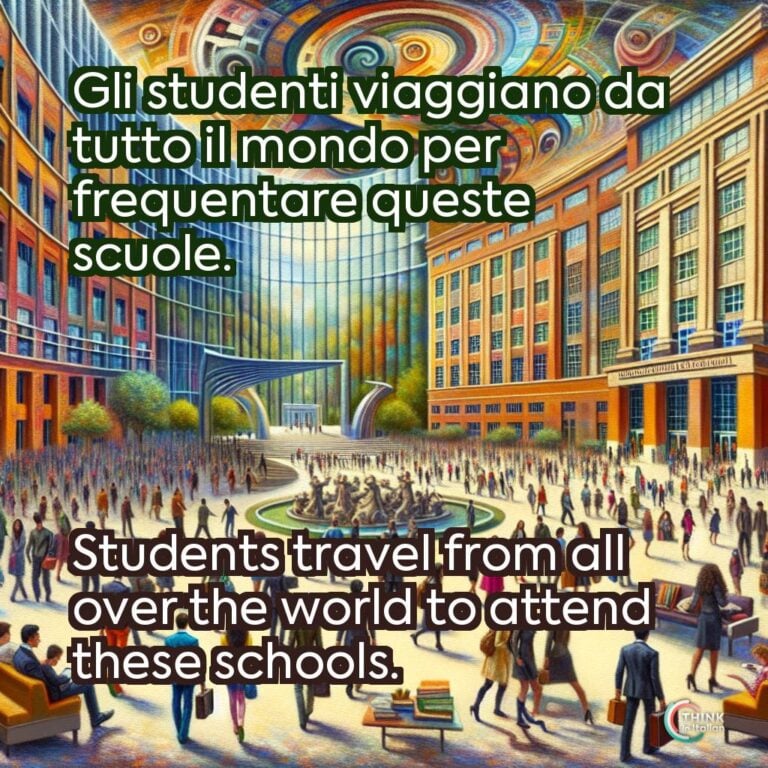Italy’s Prestigious Educational Institutions
Italy is not just a land of breathtaking landscapes, exquisite cuisine, and timeless art. It’s also home to some of the world’s most prestigious educational institutions.
Italy’s reputation as a center of intellectual excellence goes back to the Middle Ages: Italian universities have long been leading places of learning and innovation.
These institutions have nurtured some of the brightest minds in history, including Galileo Galilei, Dante Alighieri, and Leonardo da Vinci, and continue to attract students from around the world.
Important Italian figures show the perpetual effect of Italy’s educational system, inspiring future generations to innovate and excel.
Let me guide you through Italy’s renowned schools. We will explore their historical significance, unique programs, and the transformative experiences they offer.
The Oldest Universities
The University of Bologna: the Birthplace of Higher Education
Founded in 1088, the University of Bologna holds the title of the world’s oldest university in continuous operation.
It is known as the Alma Mater Studiorum (Nourishing Mother of Studies), and it pioneered the modern university system with its organization of faculties and degrees.
Bologna is a hub for humanities, law, and engineering, boasting notable alumni like Nicolaus Copernicus. The city itself mirrors the intellectual vibrancy of its students.
The University of Padua: a Renaissance Powerhouse
Established in 1222, Padua thrived during the Renaissance, becoming a center for groundbreaking discoveries.
Galileo Galilei lectured here, conducting experiments that shaped modern science. Its botanical garden, the oldest in the world, symbolizes Padua’s commitment to the study of nature.
The University of Naples Federico II: Bridging Eras
Founded in 1224, Naples Federico II combines historical significance with modern innovation.
Specializing in engineering and computer science, it continues to serve as a bridge between Italy’s intellectual past and technological future.
Centers of Innovation: Emerging and Specialized Institutions
Politecnico di Milano: Science and Technology Leader
This technical university, founded in 1863, is among the most prestigious institutions in engineering, architecture, and design. With its state–of-the-art AI and robotics laboratories, students collaborate on projects shaping the future.
Sant’Anna School of Advanced Studies (Pisa): a Modern Jewel
This public university focuses on applied sciences, robotics, and bioengineering. Renowned for its interdisciplinary research and international collaborations, Sant’Anna represents the future of innovation in Italy.
Humanitas University (Milan): Advancing Medical Education
Humanitas specializes in life sciences, putting together research and clinical practice. Programs are conducted in English, attracting students from across the globe, while its emphasis on innovation secures its position as a leader in medical training.
The Artistic Soul of Italy
Accademia di Belle Arti di Roma: Birthplace of Creativity
The Rome Academy of Fine Arts focuses on visual arts, painting, and sculpture, taking the Eternal City as its classroom. From drawing at the Colosseum to studying light under the shadow of the Pantheon, students find inspiration in Rome’s timeless beauty.
International School of Comics (Florence): Creativity Meets Industry
This institution combines modern digital art with traditional techniques, preparing students for their future careers in animation, graphic design, and other creative industries.
The University of Florence: A Renaissance Capital
Known for its excellence in art history, architecture, and design, Florence offers a unique learning environment where lectures extend into the Uffizi Gallery and other iconic sites.
Italy’s Culinary and Language Schools
Culinary Excellence
Italy is known for its cuisine, and this spills into the country’s cooking schools, such as Alma International School of Italian Cuisine. These schools train the students on–the-job, teaching the ways of Italian cooking and wines by farm-to-table manner.
Language Immersion
Language schools in Italy, like the Scuola Leonardo da Vinci, immerse their students in the Italian language and culture.
Most of these schools offer complementary courses in English, French, and Spanish for the many international students who come to embrace Italy’s linguistic heritage.
Applying to Italian Schools: Tips for International Students
Language Proficiency
Italian proficiency is generally an essential requirement, particularly for programs taught in Italian. Many universities and schools require students to have a fluency level of at least B1 or B2, according to international language certifications.
Regarding programs taught in English, especially those universities like Bocconi University or Humanitas University, evidence of proficiency in the said language is usually required, normally through tests like IELTS or TOEFL.
This is regardless of whether the language of instruction for a particular program is Italian or not. Learning some Italian will greatly help in daily living, cultural adjustment, and establishing relationships.
Institution and Program Research
Italy has everything from very old universities such as Bologna and Padua to more specialized schools like the Politecnico di Milano and the Accademia di Belle Arti.
Each institution has its own culture, strengths, and admission requirements. Take the time to review the available programs, faculty expertise, and resources such as libraries, labs, and cultural activities.
Virtual tours, webinars, and open days can also be offered by universities to prospective students to aid in making an informed decision.
Admission Requirements
Admission criteria vary by institution and program, so it’s crucial to carefully review each school’s specific requirements. Most applications require:
- A completed application form.
- Academic transcripts and diplomas translated into Italian (if applicable).
- Proof of language proficiency.
- A statement of purpose or motivational letter.
- Letters of recommendation.
- A valid passport or identity document.
For specialized programs, such as art or design, a portfolio may also be required. Some institutions may conduct interviews or entrance exams, particularly for highly competitive fields like medicine, engineering, or business.
Visa and Residency Permits
Students from non-EU countries should obtain a student visa before their arrival in Italy. Usual requirements include proof of admission to an Italian institution, sufficient finances to support yourself, and health insurance.
Upon arrival in Italy, students should apply for a residence permit (permesso di soggiorno) no later than eight days from arrival. It is mandatory to obtain this document to legally stay in the country and enjoy a number of students’ benefits.
Scholarships and Financial Aid
Scholarships and financial aids for international students in Italy include government-funded grants, regional scholarships, and merit-based awards from individual universities.
Check the Italian Government Scholarships for Foreign Students or research programs at institutions like Politecnico di Milano and Bocconi University.
Most of the regions in Italy also have need-based financial support, so it would be worth checking if your university falls under any regional aid programs.
Cultural and Practical Preparations
Settling into life in Italy is more than academics. Look into the city where your institution is located for its cost of living, transportation, and housing.
Most universities have student accommodations or work with local agencies for housing. Understand the customs, traditions, and daily way of life that Italians go about to make your transition smoother.
Cultural events, student organizations, and local attractions will enhance your experience and help you build a network of support.
Health and Insurance
Italy requires all international students to have valid health insurance.
Students from the EU can use their European Health Insurance Card, while non-EU students need to purchase private insurance or register with the Italian National Health Service (Servizio Sanitario Nazionale).
Access to healthcare is relatively affordable, and the SSN offers comprehensive coverage, including doctor visits, hospital stays, and specialist care.
How to Overcome the First Days
Coming to a new country is overwhelming, so plan your first days wisely.
Many universities organize orientation weeks for international students, providing an opportunity to meet your peers, learn about campus resources, and settle into your new environment.
Take advantage of these events to ask questions, make friends, and start building your community.
Coming to Italy to Study?
Italy’s prestigious educational institutions offer much more than degreesç they offer a journey through history, innovation, and culture.
From walking historic halls in Bologna, to exploring Renaissance treasures in Florence, to shaping the future at Politecnico di Milano, students in Italy are assured a world-class education and an opportunity to contribute to a legacy of excellence.
As Italians say, la conoscenza è un viaggio, non una destinazione (knowledge is a journey, not a destination). Where will your journey take you?






